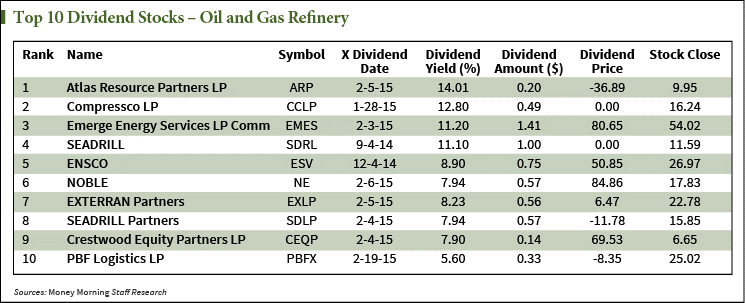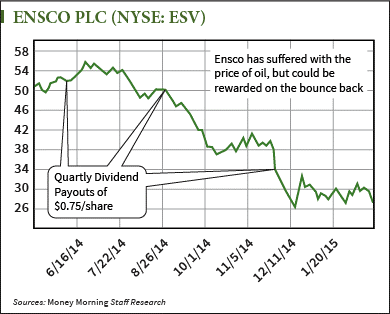[Editor's Note: Tom Gentile is the co-founder of Optionetics, a financial education company which he later sold to one of the world's largest retail brokerages. Tom leveraged his 25 years of experience trading stocks, futures, and options to teach more than 300,000 people the secrets to profitable, low-risk investing.
Tom is the author of a book, The Trading Index Course, which lays out the basis of his highly successful system for trading options, and he's a frequent contributor to CNBC, Reuters, Bloomberg, and FOX. We're excited to have him with us...]
Oil has been a glutton for punishment, getting rocked by sellers and dropping some 55% from the highs of last July.
Up until just a few months ago, nearly every analyst and hedge fund manager in this space was offering up his or her commentary on how oil had bottomed and how it was time to buy.
Now it seems that fewer traders are willing to make that call, offering a glimmer of hope for contrarians like myself.
In fact, less than two weeks ago, I published a report on the upcoming oil bounce, as well as ways to profit from the expected move higher. One of the safer ways to play the seasonal oil bounce is to look at energy stocks that pay a dividend.
Assess Energy Dividends with a Wary Eye
But beware, not all dividend stocks are created equal. I recently pulled the oil and gas stocks that pay the highest dividends and here's what I found:
 This chart is the current Top 10 oil and gas refining stocks. Look closely at this list. The top four have double-digit dividend yields. They might look great on the surface, but don't go for them; it's likely a trap! Let me explain why.
This chart is the current Top 10 oil and gas refining stocks. Look closely at this list. The top four have double-digit dividend yields. They might look great on the surface, but don't go for them; it's likely a trap! Let me explain why.
Growing companies reward their shareholders in one of two ways, either through stock appreciation (buybacks, high demand, etc...) or through dividend payouts to shareholders. Now a lot of longer term traders migrate toward dividend stocks as they age, considering them safer. They don't move around much, and they are supposed to pay out regular dividends.
Upon further review, we see that on the day that a dividend is paid out to a shareholder (the ex-dividend day), the stock price should drop by the amount of the dividend.
For instance, if XYZ is trading at $20 a share, and pays a $0.50 quarterly dividend on May 1, you can bet that on May 1, the stock will open $0.50 lower (+/- other market variables) than it closed on the previous day. Over time, however, the buyer of XYZ should expect the stock to rebound, and the trader realizes a gain in the amount of regular dividend payouts. But what happens when a stock drops such as many of the oil, gas, and energy stocks have in the last several months?
When something looks too good to be true, it probably is. It's no exception for oil stocks. As stock prices drop, dividend yields will automatically rise, if the dividend payout remains the same. The problem is, with the price of oil at multiyear lows, these double-digit dividend yields won't be around long as companies will slash dividend payouts to retain needed cash for future operations.
So which of the companies on our list won't cut their dividend yield?
 My pick is Ensco Plc. (NYSE: ESV), which was number five on our ranking above.
My pick is Ensco Plc. (NYSE: ESV), which was number five on our ranking above.
Ensco is in a stronger position than most on the list, yet still pays an impressive 8.9% dividend yield. With the stock currently trading around $27, it would cost roughly $2700 to own 100 shares. If Ensco keeps their quarterly dividend payout at $0.75 a share, that would contribute $2.25 to your numerator in determining your effective yield for the year. If the price of oil does rebound, that, too, would (contingent upon other variables) improve your yield.
"Supercharging" Your ROI
Keep in mind that in order to receive the three quarterly dividends in the above example, you would have to hold the stock for the rest of the year.
But did you know there is something else that can supercharge your return on investment while holding the stock? It won't cost you a thing; in fact, it will lower your cost of investment by around $350. That's like putting racing gas in your car, but paying for the cheap stuff! A simple "covered call" option will allow you to sell your stock at a price of $28 by January 2016, and for this you will receive around $3.50 per share for this contract.
A Taste of the Opportunity
For those of you who are new to options, I'll tread lightly here to illustrate a point that I'll more fully flesh out in upcoming issues of Money Morning.
For starters, a covered call is when an investor stays invested in a stock while selling a call (or "buy") option on that same stock.
Covered option plays are especially effective for higher dividend stocks because they can reduce cost and risk, and serve as a way of unwinding the position at a pre-determined price.
So while the cowboys of the oil markets try and pick short-term tops and bottoms, we can sit back, collect our premium and dividend yields, and play it safe in an unsafe environment. That's right where we are on Ensco, and why I'd add a conservative call option to my purchase.
About the Author
Tom Gentile, options trading specialist for Money Map Press, is widely known as America's No. 1 Pattern Trader thanks to his nearly 30 years of experience spotting lucrative patterns in options trading. Tom has taught over 300,000 traders his option trading secrets in a variety of settings, including seminars and workshops. He's also a bestselling author of eight books and training courses.



